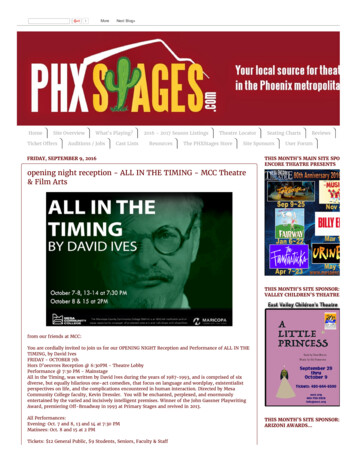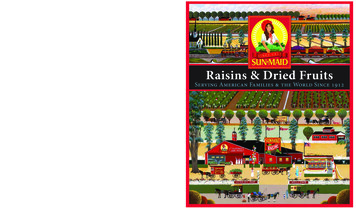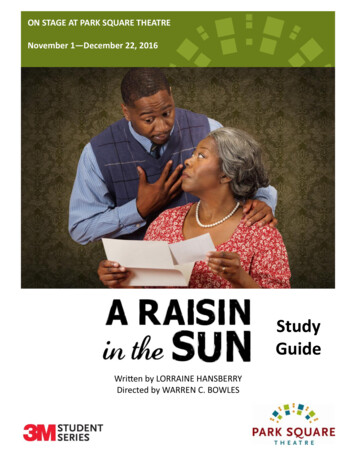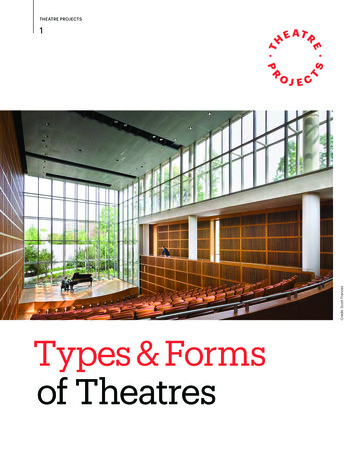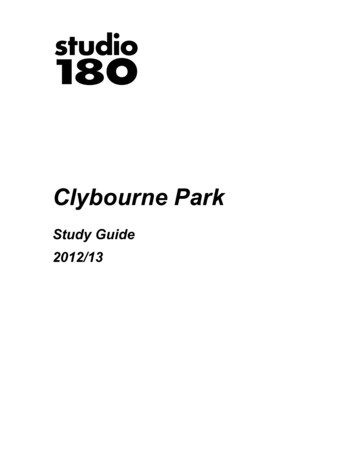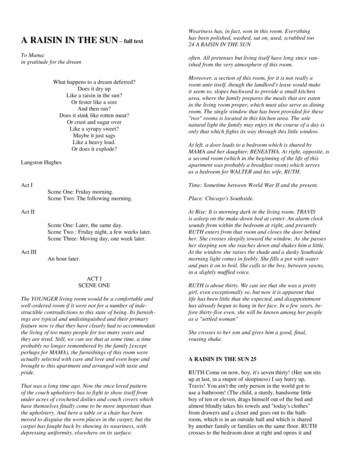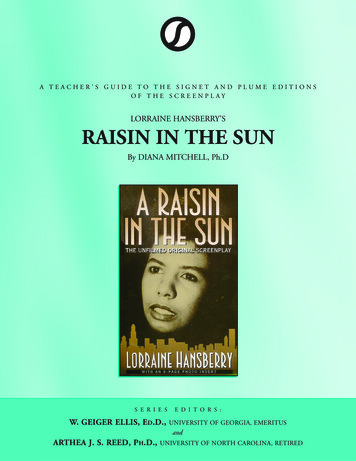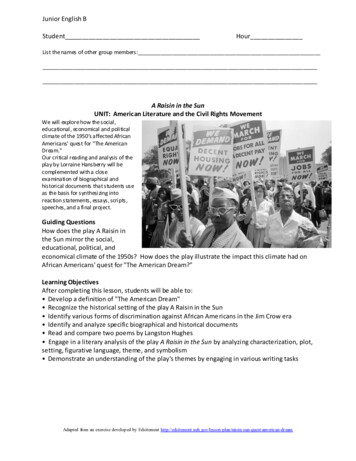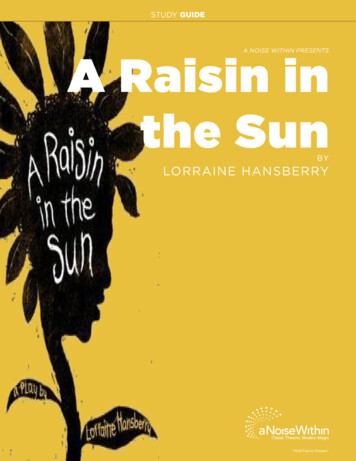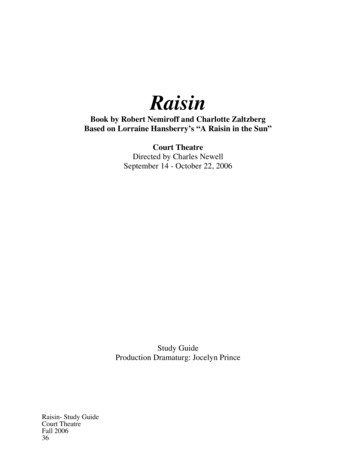
Transcription
RaisinBook by Robert Nemiroff and Charlotte ZaltzbergBased on Lorraine Hansberry’s “A Raisin in the Sun”Court TheatreDirected by Charles NewellSeptember 14 - October 22, 2006Study GuideProduction Dramaturg: Jocelyn PrinceRaisin- Study GuideCourt TheatreFall 200636
Dear Educators:Thank you for your participation in Court Theatre’s production ofRaisin. We look forward to seeing you and your class at yourscheduled performance.We hope you find this study guide helpful to you and yourstudents. The play synopsis is intended for your use. You are notobliged to provide it to your students before the play if you think itwill take away from their experience.The chapters on the Great Migration, term definitions, LorraineHansberry’s biography and the pre-show questions are basicpreparation materials for students to study before viewing the play.The plot outline worksheet can be a useful assignment to illustratedramatic structure, if your students are familiar with the terms.Information on the world of the 1950s, poems, Integration andSegregation Chronology, information on Lee v. Hansberry, imagesand post-show questions are supplementary materials to bediscussed or copied and handed out to your students as timeallows.Enjoy the show!Sincerely,Court Theatre Artistic Staff
Table of ContentsRaisin-Synopsis .3Great Migration . .4World of the 1950s . .5Integration and Segregation in the United States: Chronology .8Definition of Terms .10poem- A Dream Deferred .12poem- Kitchenette Building .13Lee v. Hansberry .14Biography of Lorraine Hansberry . 16Raisin- Plot Outline Worksheet .20Pre and Post-Show Questions .21Images.22
“Raisin”- SynopsisThis play tells the story of a working-class black family's struggleto gain middle-class acceptance. When the play opens, Mama, thesixty-year-old mother of the family, is waiting for a 10,000insurance check from the death of her husband, and the drama willfocus primarily on how the 10,000 should be spent.The son, Walter Lee Younger, is so desperate to be a betterprovider for his growing family that he wants to invest the entiresum in a liquor store with two of his friends. Mama objects mainlyfor ethical reasons; she is vehemently opposed to the idea ofselling liquor. Minor conflicts erupt over their disagreements.When Mama decides to use part of the money as a down paymenton a house in a white neighborhood, her conflict with Walterescalates and causes her deep anguish. In an attempt to makethings right between herself and her son, Mama entrusts WalterLee with the rest of the money. He immediately invests it secretlyin his liquor store scheme, believing that he will perhaps quadruplehis initial investment.One of Walter Lee's prospective business partners, however, runsoff with the money, a loss that tests the spiritual and psychologicalmettle of each family member. After much wavering andvacillating, the Youngers decide to continue with their plans tomove--in spite of their financial reversals and in spite of theirhaving been warned by a weak representative of the whiteneighborhood that blacks are not welcome.Raisin- Study GuideCourt TheatreFall 200631
Great MigrationChicago’s African American population increased dramatically between1890 and 1920, when many African Americans moved north to find betterjobs and to flee widespread racial violence. By 1910 the black population inChicago had reached 40,000 among 2 million inhabitants; by 1920 it was80,000, and a second, smaller black neighborhood had developed on theWest Side. The community developed its own institutions, including ahospital, a training school for nurses, lodges, a bank, a YMCA settlementhouse, and branches of the National Negro Business League, the NAACP,and the Federated Women’s Clubs. In 1905 Robert Abbott founded theChicago Defender newspaper.The Great Migration's impact on cultural life in Chicago is most evident inthe southern influence on the Chicago Renaissance of the 1930s and 1940s,as well as blues music, cuisine, churches, and the numerous family andcommunity associations that link Chicago with its southern hinterland—especially Mississippi.In the 1940s and 1950s, blacks had once again migrated in enormousnumbers from the South. The South Side community tried to expand butmet with both legal and violent opposition. The Great Migration establishedthe foundation of Chicago's African American industrial working class.Despite the tensions between newcomers and “old settlers,” related todifferences in age, region of origin, and class, the Great Migrationestablished the foundation for black political power, business enterprise, andunion activism.Raisin- Study GuideCourt TheatreFall 20065
World of the 1950sPopulation: 151,684,000 (U.S. Dept. of Commerce, Bureau of the Census)Unemployed: 3,288,000Life expectancy: Women 71.1, men 65.6Car Sales: 6,665,800Average Salary: 2,992Labor Force male/female: 5/2Cost of a loaf of bread: 0.14Bomb shelter plans, like the government pamphlet You Can Survive, becomewidely availableMusic: When the 1950's are mentioned, the first type of music to come tomost people's minds is rock 'n roll . Developed from a blend of Southernblues and gospel music with an added strong back beat, this type of musicwas popular with teenagers who were trying to break out of the mainstreamconservative American middle class mold. Popular artists such as BillHaley, Elvis Presley, and Jerry Lee Lewis were promoted on radio by justas popular disc-jockeys (DJ's) like Alan Freed and the Big Bopper. Music inthe Fifties was more than just rock 'n roll. Crooners like Nat King Cole,Frank Sinatra, Perry Como and Dinah Shore were all popular.Popular Songs: “A Bushel and A Peck,” “Kisses Sweeter Than Wine,” “ISaw Mommy Kissing Santa Claus,” “Rock Around the Clock,” “WhateverLola Wants,” “Hound Dog,” “Love Letters in the Sand,” “The Purple PeopleEater,” “He’s Got the Whole World in His Hands,” “High Hopes”Literature/Theater:Gwendolyn Brooks: “Annie Allen,” Pulitzer Prize for poetry (1950)Carl Sandburg: “Complete Poems,” Pulitzer Prize (1951)Ralph Ellison: “The Invisible Man” (1952)Samuel Beckett: “Waiting for Godot” (1952)Arthur Miller: “The Crucible” (1953)Nobel Prize for Literature: Ernest Hemingway (1954)Charles A. Lindbergh: “The Spirit of St. Louis,” Pulitzer Prize for biography(1954)Tennesse Williams: “Cat on a Hot Tin Roof,” Pulitzer Prize drama (1955)Goodrich and Hackett: “The Diary of Anne Frank,” Pulitzer Prize drama(1956)Raisin- Study GuideCourt TheatreFall 200633
Jack Kerouac: “On the Road” (1957)Dr. Seuss: “The Cat in the Hat” (1957)Lorraine Hansberry: “A Raisin in the Sun” (1958)John Updike: “Poorhouse Fair” (1959)Major Events:-Senator Joseph McCarthy advises President Truman that State Departmentis riddled with Communists and Communist sympathizers (1950)-Riots in Johannesburg against apartheid (1950)-1.5 million TV sets in U.S. (one year later approx. 15 million) (1950)-Julius and Ethel Rosenberg are sentenced to death for espionage against theU.S. (1951)-Color television is first introduced (in U.S.) (1951)-Dwight Eisenhower resigns as Supreme Commander in Europe; electedPresident of the U.S. (1952)-Israel and Germany agree on restitution for damages done to Jews by theNazis (1952)-Korean armistice signed at Panmunjom July 27; U.S. and South Korea signmutual defense treaty (1953)-U.S. Supreme Court rules that segregation by color in public schools is aviolation of the 14th Amendment to the Constitution (1954)-Sugar Ray Robinson wins world boxing championship from Carl “Bobo”Olson (1955)-Mary McLeod Bethune, American educator and civil rights leader dies(1955)-Sudan proclaimed independent democratic republic (1956)-“Rock and Roll” dance is in vogue (1956)-Dwight Eisenhower reelected President of the U.S. (1956)-Tidal wave follows hurricane Audrey into coasts of Texas and Louisiana,leaving 530 dead and missing (1957)-“Beat” and “beatnik” take hold as new words to describe the “BeatGeneration” first treated in Kerouac’s “On the Road” (1957)-Alaska becomes 49th state of the U.S. (1958)-Tension grows in the U.S. as desegregation of schools is attempted in theSouth; Governor Orval Faubus of Arkansas defies Supreme Court by closingschools in Little Rock, reopening them as private, segregated schools (1958)-U.S. establishes National Aeronautics and Space Administration (NASA) toadminister scientific exploration of space (1958)-Belgium grants reforms in Congo (1959)Raisin- Study GuideCourt TheatreFall 200634
-Hawaii becomes 50th state of the U.S. (1959)-Cuban president Batista flees to the Dominican Republic; Fidel Castrobecomes Premier of Cuba; expropriates U.S.- owned sugar mills (1959)What cost .50 in 1955 would cost 3.44 in 2005.Also, if you were to buy exactly the same products in 2005 and 1955,they would cost you .50 and 0.07 respectively.What cost 10000 in 1955 would cost 68704.15 in 2005.Also, if you were to buy exactly the same products in 2005 and 1955,they would cost you 10000 and 1455.52 respectively.Average Annual Salary: 2,992Raisin- Study GuideCourt TheatreFall 200635
Integration and Segregation in the United States: Chronology1861-65Civil War years.1866Ku Klux Klan established in Tennessee.1870Passage of Fifteenth Amendment to U.S. Constitution prohibiting racialdiscrimination in voting.1882Chinese Exclusionary Act banning Chinese immigration to the United Statesfor ten years.1896Plessy v. Ferguson Supreme Court decision permitting "separate but equal"public racial facilities.1907Supreme Court declares that railroads have the right to segregate passengers.1909National Association for the Advancement of Colored People (NAACP) founded.1911National Urban League founded.1919Race riots in Chicago.1924Immigration Act establishing quotas based on national origin.1927Urban League organizes boycott of stores refusing to hire blacks.1943Race riots in Detroit.1946Supreme Court declares that segreagation on buses is unconstitutional.1947Jackie Robinson becomes first African American to play major league baseball.1948President Truman issues executive order integrating armed forces.1949Supreme Court rules that local "covenants" enforcing segregated neighborhoodsare unconstitutional. National Housing Act addressing substandard housing.1954Brown v. Board of Education Supreme Court ruling that "separate but equal"doctrine regarding school segregation is unconstitutional.1955Bus boycott in Montgomery, Alabama.1957School desegregation crisis in Little Rock, Arkansas.1960"Sit-ins" begin at Woolworth's in Greensboro, North Carolina.1961"Freedom Riders" attempt to force integration in Alabama.1962African American student James Meridith is denied admission to the Universityof Mississippi, resulting in contempt charges against the governor of Mississippi.Raisin- Study GuideCourt TheatreFall 200637
Integration and Segregation in the United States: Chronology1963George Wallace's "school house stand" attempting to block integration of theUniversity of Alabama.Martin Luther King Jr. arrested in Birmingham, Alabama, while leading civilrights demonstrations.March on Washington, D.C., demonstrating for civil rights.Medgar Evers assassinated.1964Twenty-Fourth Amendment to the Constitution ratified, abolishing the poll tax.Martin Luther King, Jr. wins the Nobel Peace Prize.Race riots in Harlem.1965Malcolm X assassinated.Martin Luther King Jr. leads march from Selma to Montgomery, Alabama.Race riots in Watts, Los Angeles.Immigration law abolishes quota system.Voting Rights Bill passed.1967Black Power conference held in Newark, New Jersey.Race riots in Cleveland, Newark, and Detroit.1968Civil Rights Act of 1968 guaranteeing fair treatment in housing.Martin Luther King Jr. assasinated.Raisin- Study GuideCourt TheatreFall 200638
Definition of TermsGhetto“Ghetto” is a term with a long history, originally referring to Jewishenclaves within European cities, which were physically separated fromsurrounding areas, but whose economic institutions often played animportant role in the life of the greater city. In American cities, includingChicago, the changing dynamics of the process known as ghettoization haveparalleled shifts in racial-ethnic composition and underscored the effects ofmajor public policy breakdowns.In the early twentieth century, the predominantly Eastern European JewishMaxwell Street area on the Near West Side, through the research ofsociologist Louis Wirth, earned the appellation of “the ghetto.” UnlikeEuropean ghettos, this community of indigenously controlled culturalinstitutions and businesses was in no explicitly physical or legal fashionsegregated from the remainder of Chicago. By the 1920s, however, on thecity's South Side, a cluster of adjoining neighborhoods were congealing intoa Black Belt, whose long-standing character would give a new meaning tothe term “ghetto.”The original South Side Black Belt formed in response to external pressures,including discriminatory real-estate practices and the threat of violence inadjoining white neighborhoods. By the 1950s, the Chicago HousingAuthority's (CHA) project-siting practices further contributed to theconcentration of African Americans in the old South Side Black Belt and ina second band of neighborhoods on the city's West Side.Black BeltFrom the turn of the twentieth century until after World War II, the term“Black Belt” was commonly used to identify the predominately AfricanAmerican community on Chicago's South Side. Originally a narrow corridorextending from 22nd to 31st Streets along State Street, Chicago's South SideAfrican American community expanded over the century until it stretchedfrom 39th to 95th streets, the Dan Ryan Expressway to Lake Michigan.Raisin- Study GuideCourt TheatreFall 20063
Restrictive CovenantsRacially restrictive covenants, in particular, are contractual agreementsamong property owners that prohibit the purchase, lease, or occupation oftheir premises by a particular group of people, usually African Americans.RedliningRedlining is the practice of arbitrarily denying or limiting financial servicesto specific neighborhoods, generally because its residents are people of coloror are poor. Like other forms of discrimination, redlining had pernicious anddamaging effects. Without bank loans and insurance, redlined areas lackedthe capital essential for investment and redevelopment. As a result, afterWorld War II, suburban areas received preference for residential investmentat the expense of poor and minority neighborhoods in cities like Chicago.The relative lack of investment in new housing, rehabilitation, and homeimprovement contributed significantly to the decline of older urbanneighborhoods and compounded Chicago's decline in relation to its suburbs.KitchenettesThe “kitchenette” initially described a newly constructed small apartment inChicago, first appearing around 1916 in Uptown, at a time when apartmentconstruction in the city was increasing dramatically. It featured “Pullmankitchens” and “Murphy in-a-door beds” to conserve space, and connotedefficiency and modernity.Raisin- Study GuideCourt TheatreFall 20064
A Dream Defferedpoem by Langston HughesWhat happens to a dream deferred?Does it dry uplike a raisin in the sun?Or fester like a sore-And then run?Does it stink like rotten meat?Or crust and sugar over-like a syrupy sweet?Maybe it just sagslike a heavy load.Or does it explode?Raisin- Study GuideCourt TheatreFall 20061
Kitchenette Buildingpoem by Gwendolyn BrooksWe are things of dry hours and the involuntary plan,Grayed in, and gray. "Dream" mate, a giddy sound, not strongLike "rent", "feeding a wife", "satisfying a man".But could a dream sent up through onion fumesIts white and violet, fight with fried potatoesAnd yesterday's garbage ripening in the hall,Flutter, or sing an aria down these rooms,Even if we were willing to let it in,Had time to warm it, keep it very clean,Anticipate a message, let it begin?We wonder. But not well! not for a minute!Since Number Five is out of the bathroom now,We think of lukewarm water, hope to get in it.Raisin- Study GuideCourt TheatreFall 200622
Lee v. HansberryHansberry v. Lee, 311 U.S. 32 (1940) is a famous case now usually knownin Civil Procedure for teaching that res judicata may not bind a subquentplaintiff who had no opportunity to be represented in the earlier civil action.The facts of the case dealt with a racially restrictive covenant amongstmembers of a class which would have called for excluding Carl Hansberry,the father of famous author Lorraine Hansberry, merely because people bothbelieved in the biologically discredited theory of race and according to thattheory, that he was black. The defendants asserted that since Hansberry wasa class member, he should be bound by the prior decision. Justice HarlanFiske Stone held that since he didn't have an opportunity to be heard,enforcing that racial covenant would deny him his due process rightsguaranteed by the Fourteenth Amendment.Later, the type of real property restriction, racially restrictive covenants, washeld by Shelley v. Kraemer, 334 U.S. 1 (1948) to be state action because theplaintiffs seeking to enforce such a covenant was invoking the machinery ofthe state.In June of 1937, white residents of the Woodlawn neighborhood (60th to 67thnorth-south, and Lake Michigan to what is not MLK Dr (then South ParkAve) east-west), represented by lawyers of the Woodlawn Property Owner’sAssociation filed suit against Carl Hansberry and his wife Nannie (theirdaughter Lorraine was at this time 7 years old) who had purchased propertyat 6140 S. Rhodes Ave. The Hansberrys had previously been forced tovacate a property at 549 E 60th St. due to the influence of racially restrictivecovenant.Lee v. Hansberry was a first ruled in Circuit Court in favor of the Plaintiffs.The Hansberrys and their co-dependents appealed a series of lower courtrulings and finally landed before the Supreme Court in November, 1940.The Supreme Court decided in favor of the Hansberrys, opening up morethan 300 properties in the Woodlawn neighbordhoof to African-Americaninhabitants. However, the Court did not at this time strike down raciallyrestrictive covenants as racist and unconstitutional, but rather found that inthis particular case their use had been fradulent.Raisin- Study GuideCourt TheatreFall 200623
Excerpt from the Racial Restrictive Covenant of the Washington ParkSubdivision in the City of Chicago:“The restriction that no part of said premises shall in any manner be used oroccupied directly or indirectly by any negro or negroes, provided that thisrestriction shall not prevent the occupation, during the period of theiremployment as janitors’ or Chauffeurs’ quarters in the basement or in a barnor garage in the reat, or of servants’ quarters by negro janitors, employed assuch for service in and about the chauffeurs or house servants, respectively,actually employed as such for service in and about the premises by therightful owner or occupant of said premises.”“The iron band of restrictive covenants which has checked the eastwardmovement of the Race on Chicago’s South Side was pierced at one point bya decision handed down by the United States Supreme Court Tuesday. Theruling upheld the contention of Carl Hansberry, prominent South Siderealtor, and others, that the property owners agreements barring Negroesfrom residing in an area bounded by Sixtieth and Sixty-third streets, SouthParkway and Cottage Grove avenue, are non-existent. The decision makesavailabel to Negroes approximately 300 additional parcels of property.”--The Chicago Defender, Saturday, November 16, 1940Raisin- Study GuideCourt TheatreFall 200624
Biography of Lorraine HansberryI’m not talking about Black racism. Let’s keep in mind what we’re talkingabout. We’re talking about oppressed peoples who are saying that they mustassert themselves in the world Let’s not equalize the oppressed with the oppressor and saying that whenpeople stand up and say that we don’t want any more of this that they arenot talking about a new kind of racism. My position is that we have a greatdeal to be angry about, furious about. You know it’s 1959 and they are stilllynching [killing] Negroes in America. And I feel, as our African friends do,that we need all ideologies which point toward the total liberation of theAfrican peoples all over the world.--Lorraine HansberryDuring the 1950s and until her untimely death in 1965, Lorraine Hansberrywas a prominent voice crying for the “total liberation of African peoples allover the world,” especially the liberation of African-Americans in theirprotracted struggle for freedom and equality.Raisin- Study GuideCourt TheatreFall 200627
Hansberry’s influence as an artist and activist is best understood byexamining the social, political, and historic contexts through which shesought to convey the experiences of oppressed people who were determinedto “assert themselves in the world.” Malcolm X described this period as “atime when there’s a revolution going on, a worldwide revolution.”Hansberry herself corroborated Malcolm’s views by saying, For me this isone of the most affirmative periods in history. I am very pleased that thosepeoples in the world whom I feel closest to, the colonial peoples, the Africanpeople, the Asian peoples, are in an insurgent mood and are in the process oftransforming the world and I think for the better. I can’t quite understandpessimism at this moment unless of course one is wedded to things that aredying out which should die out like colonialism, like racism.”It was in this global context of change that Hansberry’s controversial play, ARaisin in the Sun (1959), signaled a new era for the role of the black artist inthe American civil rights struggle, a post-Brown v. Board of Educationperiod in which there was a vortex of direct actions and protests by blacksagainst racism and discrimination in American life. This was also a timethat saw the emergence of diverse civil rights organizations and leaders,often with different and competitive ideologies, tactics, and agendas forblack liberation throughout the world. Examples of these organizations andindividuals are the Southern Christian Leadership Conference (SCLC) andDr. Martin Luther King, Jr.; The Student Nonviolent CoordinatingCommittee (SNCC) and Stokely Carmichael, Rap Brown, Malcolm X andothers.Hansberry’s listing recognizes the impact of her ideals and work, especiallyin the play A Raisin in the Sun, in conveying to black and white society thesinglemindedness and persistence of blacks to be- to overcome white racismand oppression.Measures of the impact of A Raisin in the Sun go beyond it being the firstplay on Broadway by a black female playwright. One must also mention theplay’s lengthy run of 538 performances which indicated its acceptance bywhite society, the patrons of Broadway theater; Hansberry’s New YorkDrama Critics Circle Award for Best Play of the Year in 1959; and theopportunities provided for black artists, like Sidney Poitier, Ruby Dee, LouGossett, and black director, Lloyd Richards, and others to display theirconsiderable talents on Broadway. A the same time, A Raisin in the SunRaisin- Study GuideCourt TheatreFall 200628
opened the doors for other blacks to the economic potential of a multibilliondollar entertainment complex (Broadway and Off-Broadway), which wouldwitness an unprecedented rise in black theatre during the 1960s, 1970s and1980s.Lorraine Vivian Hansberry was born on May 19, 1930 in Chicago, to Carl, asuccessful real estate broker, and Nannie, a schoolteacher. Her maternalgrandparents were slaves. Both her parents were active politically, hermother as a ward committeeperson and her father as a member of theNational Association for the Advancement of Colored People (NAACP) andthe Urban League, as a United States marshal, and an unsuccessful candidatefor the United States Congress.Hansberry attended public elementary schools on the southeast side ofChicago. While in the third grade, her family moved into an all-whiteneighborhood on the South Side of Chicago, where they were taunted,harassed, and forced to leave the neighborhood by a lower court ruling thatupheld restrictive housing covenants in Chicago, which barred blacks frommoving into white areas. Her father challenged this ruling all the way to theSupreme Court and, in 1940, the Court, in Hansberry v. Lee, struck downrestrictive covenants. This struggle against discrimination in housing andother areas would later become the theme of A Raisin in the Sun and otherworks.Hansberry graduated from Englewood High School in Chicago in 1948- alsothe alma mater of Gwendolyn Brooks. She then attended the University ofWisconsin, where she developed her interests in theatre. Leaving Wisconsinafter two years, she studies painting at several schools, including the ArtInstitute of Chicago.In 1950, she moved to New York City, studying briefly at the New Schoolfor Social Research. During that year, she also met Paul Robeson andstarted working as a reporter for his newspaper, Freedom, becoming anassociate editor in 1952. During her association with Robeson and others,like W.E.B. Dubois and her uncle, renowned Africanist historian WilliamLeo Hansberry, she developed a global view of the struggle of all oppressedpeoples- black and nonblack.In 1953, she married Robert Nemiroff, a writer, composer, and Communistactivist. By this time Hansberry had started writing essays and plays. InRaisin- Study GuideCourt TheatreFall 200629
1957, inspired by her childhood experiences with racism and discrimination,she wrote the first version of A Raisin in the Sun. The title was adapted froma line of Langston Hughes’ famous poem, “Harlem,” in which he prophesiedthe dire consequences of “a dream deferred,” drying up “like a raisin in thesun” and festering and exploding like the dynamite of “frustrated hopes andpent-up folk consciousness.” Richard Wright and others saw and felt thatfrustration during the four decades preceding the Brown v. Board ofEducation era.After successful runs of A Raisin in the Sun in New Haven, Philadelphia andChicago, it opened on Broadway at the Ethel Barrymore Theatre on March11, 1959, the first significant black play on Broadway since LangstonHughes’ Mulatto in 1938. Hansberry say A Raisin in the Sun asunambiguously portraying the “fact of racial oppression The reason thesepeople are in the ghetto in America is because they are Negroes.”Other significant works by Hansberry illuminating the black struggle againstracial oppression are The Movement: A Documentary of a Struggle forRacial Equality in the USA (1964); The Sign in Sidney Brustein’ Window(1965); To Be Young, Gifted, and Black: Lorraine Hansberry in Her OwnWords [adapted by Nemiroff, 1969]; and Les Blancs: The Collected LastPlays of Lorraine Hansberry (edited by Nemiroff, 1972).Lorraine Hansberry died of cancer on January 12, 1965, in New York City.Another measure of her impact on African-Americans can be seen by theattendance of Paul Robeson, Ossie Davis and Malcolm X among thehundreds of mourners at her funeral on January 16, 1965, at Church of theMaster on 122nd Street in Harlem, nearly one month before the assassinationof Malcolm X at the Audubon Ballroom in Harlem.Raisin- Study GuideCourt TheatreFall 200630
“Raisin” – Plot OutlineStudent Name: Date:Use the traditional pyramidal structure to map the important partsof the plot.1. Exposition/Situation2. Rising Action3. Complication4. Climax5. Falling Action6. ResolutionRaisin- Study GuideCourt TheatreFall 20062
Pre-Show Questions1) Where and when is the play set?2) Does the set look realistic or abstract? Can you tell the characters’standard of living based on the set? How does the set incorporate theaudience members?3) How is music used in the play?4) What is the significance of the play being set in the 1950s?Post-Show Questions1) What is the significance of the play’s title?2) How does a “dream deferred” shape the lives of the characters? Whichdreams in the play are individual? Shared? Are any of the characters’ dreamsrealized?3) How does Walter Lee set up the direction of the play’s plot; what goaldoes he reference or allude to that will create a struggle for him throughoutthe course of the play?4) What does Beneatha mean when she says she is looking for her identity?Why does she like Asagai?5) What is Mama’s favorite item in the apartment?6) Who is often mentioned, but never appears as a character in the play?7) What does Travis want to be when he grows up?8) Is Ruth happy about her new pregnancy? Why or why not?Suggested Assignments1) Research the history of your city or neighborhood, focusing on how itsethnic or racial composition has (or has not) shifted. Choose a specific timeperiod to examine, such as the last ten, twenty, or fifty years.2) Choose one African nation and research its history. Focus on a particulartime period, for example, the era before colonialization, the late nineteenthcentury or the 1960s.3) Read a biography and write an essay about the life of a prominentindividual in the civil rights movement. Examples include W.E.B. Dubois,Marcus Garvey, Booker T. Washington, Rosa Parks, Martin Luther King,Malcolm X, Medgar Evers, and Ida B. Wells.4) Write a poem in which you characterize a place with which you arefamiliar.5) Define “being a man” according to Walter, Mama and Asagai.6) Write a paper offering a solution to a particular racial conflict in yourschool or community.Raisin- Study GuideCourt TheatreFall 200625
Crowded QuartersThe housing crunch in Northern cities, along with thesegregation and discrimination facing African Americansattempting to find places to live, led to extremely crowdedconditions, such as those pictured in this Chica
Raisin Book by Robert Nemiroff and Charlotte Zaltzberg Based on Lorraine Hansberry’s “A Raisin in the Sun” Court Theatre Directed by Charles Newell September 14 - October 22, 2006. Study Guide . Production Dramaturg: Jocelyn Prince .
